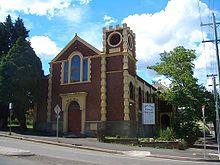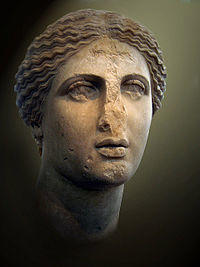
A church building in Katoomba, Australia, converted to a restaurant
Deconsecration, also called secularization,[1] is the act of removing a religious blessing from something that had been previously consecrated by a minister or priest of that religion. The practice is usually performed on churches or synagogues to be rendered to non-religious (secular) use or demolished.[2][3]

Head of Aphrodite, 1st century AD copy of an original by Praxiteles. The cross on the chin and forehead was intended to "deconsecrate" a Holy pagan artifact. Found in the Agora of Athens. National Archaeological Museum in Athens.
Deconsecration can also refer to the part of the process of converting a pagan temple to a church.[4][5] The process involves removal of the pagan statues or rendering them unsuitable for pagan worship, possibly a period when the building is used as a place of worship without any alteration and finally architectural modifications.
See also
- Consecration
- Desacralization of knowledge
- Desecration
References
- ^ Donald S. Armentrout and Robert Boak Slocum (2000). "Secularizing a Consecrated Building". An Episcopal Dictionary of the Church. The Domestic and Foreign Missionary Society.
This service is used to deconsecrate and secularize a consecrated building that is to be taken down or used for other purposes.
- ^ "Deconsecration of a London Church". The New York Times. November 3, 1876.
- ^ Temple B’Nai Israel to conduct last service in synagogue Sunday, By KATE DAY SAGER Olean Times Herald Dec 9, 2020
- ^ [https://digitalcommons.providence.edu/cgi/viewcontent.cgi?article=1036&context=art_journal Christian Conversion: The Spiritual Transformation of Eastern Pagan, Structures in Late Antiquity, Alexandra Fallone, 2013]
- ^ From Paganism to Christianity in the Temples of Athens, Alison Frantz, Dumbarton Oaks Papers Vol. 19 (1965), pp. 185+187-205